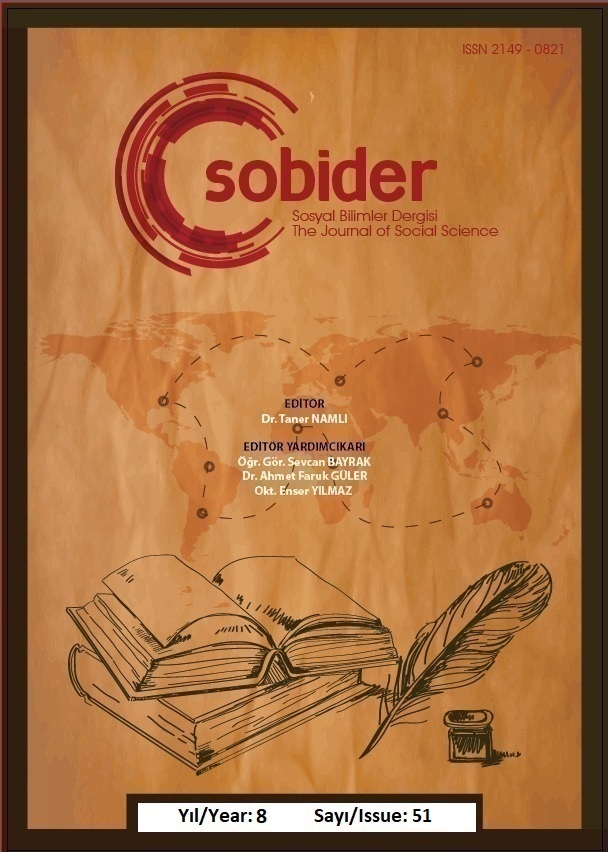1556-1557 (H. 963-964) TARİHLİ DİVÂN-I HÜMAYÛN RUÛS DEFTERİ’NE GÖRE BEYLERBEYİ VE SANCAKBEYİ ATAMALARI
Author :
Abstract
Osmanlı Devlet bürokrasisinin önemli bir parçası olan Ruûs Defterleri, Divân-ı Hümayûn’un en önemli kalemlerinden birisidir. Ruûs Defterleri genel görüşün aksine sadece alt dereceli devlet görevlilerinin tayin ve tevcihiyle ilgili değil beylerbeyileri ve sancakbeyleri de dâhil olmak üzere çoğu kere üst düzey devlet görevlilerinin tevcih ve tayinleri ihtiva eden belgeleri de içinde barındırmaktadır. Yanı sıra Ruûs Defterleri’nden Osmanlı Devleti’nin idarî, siyasî, içtimaî ve iktisadî hayatıyla ilgili bilgilere ulaşmakta mümkündür. Bu noktada ele aldığımız 1556-1557 (H. 963-964) tarihli Divan-ı Hümâyûn Ruûs Defteri’nde, beylerbeyi ve sancakbeyi atama kayıtlarından eski görevleri-görev yerleri, yeni görev yerleri, mazûliyetleri, tekaüdleri ve münhal olma durumları dâhil pek çok bilgiye yer verilmiştir.
Keywords
Abstract
Ruûs Books, an important part of the Ottoman State bureaucracy, are one of the most important items of the Diwân-ı Humayûn. Contrary to the general view, the Ruus Books contain not only the appointment and grant of lower-level government officials, but also the documents that often include the grant and appointment of high-level government officials, including beglerbegi (Governor of a province) and sancakbeyi (Governors of an administrative unit within a province). In addition, it is possible to obtain information about the administrative, political, social and economic life of the Ottoman State from the Ruûs Books. At this point, in the records of the appointment of beglerbegi and sanjakbegi, which are in the Diwân-ı Humâyûn Ruûs Book dated from 1556 to 1557 (H. 963-964), many informations including the former duties-places of duty, new places of duty, dismissals, retirements and vacant positions are included.
Keywords
- 1556- 1557 (H. 963-964) Tarihli Divan-ı Hümâyûn Ruûs Defteri (S.1-125) Metin Değerlendirme- Dizin, (Haz. Havva Merve Çıtak), Fırat Üniversitesi Sosyal Bilimler Enstitüsü, Basılmamış Yüksek Lisans Tezi, Elazığ, 2015.
- Ahıshalı, Recep, “Ruûs”, C. 35, DİA, 2008, ss. 272-273.
- Aydın, Bilgin; Günalan, Rıfat “Ruus Defterlerine Göre XVI. Yüzyılda Osmanlı Eyalet Teşkilatı ve Gelişimi”, Osmanlı Araştırmaları, S. 38, 2011, ss. 27-160.
- Emecen, Feridun, İlhan Şahin, “Osmanlı Taşra Teşkilatının Kaynaklarından 957-958 (1550- 1551) Tarihli Sancak Tevcih Defteri”, Belgeler, XIX/23, 1998, ss. 53-122.
- Ferit Develioğlu, Osmanlıca-Türkçe Ansiklopedik Lûgat, (Yay. Haz. Aydın Sami Güneyçal), Aydın Kitabevi Yayınları, 19. Baskı, Ankara, 2002. Geza David, “XVI. Yüzyılda Osmanlı-Habsburg Mücadelesinin Bir Kaynağı Olarak Mühimme Defterleri”, Tarih Dergisi, S. 53, İstanbul, 2012, ss. 295-349.
- Gökçe, Turan, 934 (1528) Tarihli Bir Deftere Göre Anadolu Vilayeti Kadılıkları ve Kadıları”, 3 Mayıs 1944 Türkçülük Armağanı, İzmir 1994, ss. 77-94.
- Göyünç, Nejat, “XVI. Yüzyılda Ruûs ve Önemi”, İÜEF Tarih Dergisi, C. XVII, S. 22, İstanbul, 1968, ss. 17-34.
- Halaçoğlu, Yusuf, XIV-XVII. Yüzyıllarda Devlet Teşkilatı ve Sosyal Yapı, TTK, Ankara, 2007.
- Metin Kunt, Sancaktan Eyalete 1550-1650 Arasında Osmanlı Ümerası ve İl İdaresi, Boğaziçi Üniversitesi Yayınları, İstanbul, 1978.
- Sami, Şemsettin, Kâmûs-ı Türkî (Latin Harfleriyle), (Haz. Raşit Gündoğdu, Niyazi Adıgüzel, Ebul Faruk Önal), İdeal Kültür Yayıncılık, 2. Baskı, İstanbul, 2012.
- Uzunçarşılı, İsmail Hakkı, Osmanlı Devleti’nin Merkez ve Bahriye Teşkilâtı, TTK, Ankara, 1988.
- Ünal, Mehmet Ali, Osmanlı Müesseseleri Tarihi, Fakülte Kitapevi Yayını, 8. Baskı, Isparta, 2010.





